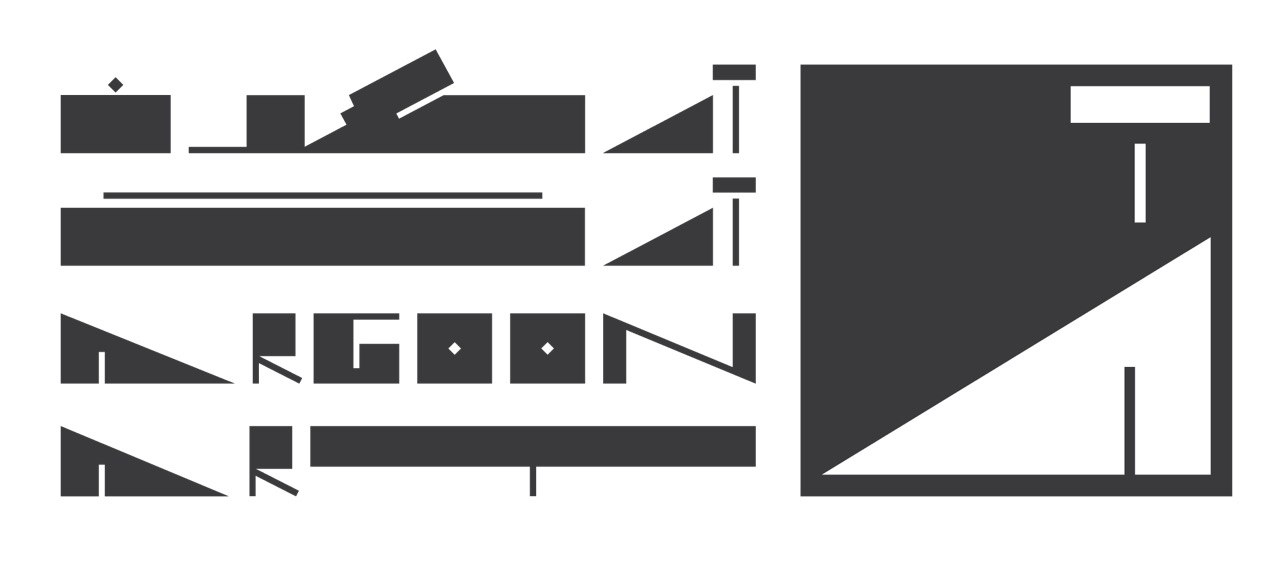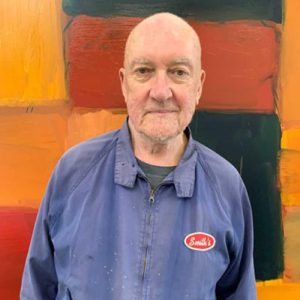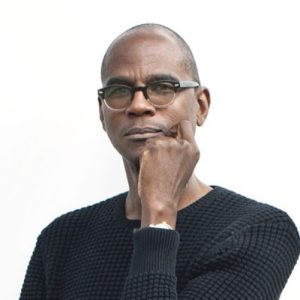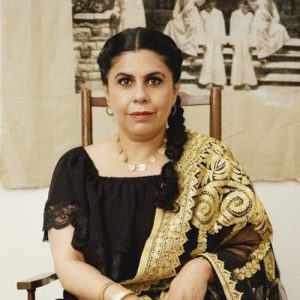
Jenny Saville was born on May 7, 1970, in Cambridge. Her parents, both educators, moved Jenny and her brothers and sister frequently from school to school as her father pursued a career as a school administrator. After attending several schools, she finished secondary school at Newark, Nottinghamshire. As a child, Saville’s parents encouraged her to think and work independently. She was first attracted to painting at the age of eight. Her mother recognized her talents early and cleared out a broom closet for Saville to use as her first studio. She cites her uncle, Paul Saville, an artist, art historian, and former head of Liberal Arts at Clare College, as an early influence. He took her to museums, but also to Holland and Italy, in order to expose her to Old Masters as well as modern artists. It was her uncle that encouraged her to pursue an art degree at the Glasgow School of Art.
Saville studied at the Glasgow School of Art in the late 1980s, graduating in 1992 with a BFA. She attended the school because of its reputation as a painting school, saying, “Every day you walk up those steps it makes you become an artist.” Without a grant or funding, she worked as a waitress in order to support herself and pay for a studio where she could paint. During her time at Glasgow School of Art, she received a six-month travel scholarship to study in the United States at the University of Cincinnati. Saville recalls seeing “big women and big white bodies in shorts and T-shirts,” an experience that influenced her to take on the un-idealised female nude as the primary focus of her early works. She enjoyed success during her last year at Glasgow School of Art and was selected twice by the National Portrait Gallery before her final graduate exhibition in the summer of 1992. In a rare feat, she sold most of the paintings from the show and an example from the exhibition subsequently appeared on the cover of the Times Saturday Review in September 1992. The cover came to the attention of art collector and advertising executive Charles Saatchi, who sought her out and offered her a contract to paint over the next eighteen months, with a promise to purchase and exhibit any paintings she produced during that time. With little money and a propensity for making large-scale paintings in oil, the contract from Saatchi allowed her to produce work without financial constraints.
Saville was offered an opportunity to return to the USA in 1994. Intrigued by the nature of plastic surgery, a phenomenon that was on the rise in the mid-1990s, she began observing surgeries in the office of a New York plastic surgeon.
Alongside contemporaries such as Damien Hirst, Tracey Emin, and Sarah Lucas, Jenny Saville’s work was included in the 1994 Young British Artists III exhibition at the Saatchi Gallery, and in the 1997 Sensation exhibition at the Royal Academy of Art in London, which was taken from Saatchi’s collection. Much lauded in the UK, Sensation sparked controversy when it traveled in 1999 to the Brooklyn Museum. Although she was included in these important exhibitions, Saville never considered herself part of the Young British Artists, most of whom worked in mediums other than painting, which she had devoted herself to since an early age.
Jenny Saville was born on May 7, 1970, in Cambridge. Her parents, both educators, moved Jenny and her brothers and sister frequently from school to school as her father pursued a career as a school administrator. After attending several schools, she finished secondary school at Newark, Nottinghamshire. As a child, Saville’s parents encouraged her to think and work independently. She was first attracted to painting at the age of eight. Her mother recognized her talents early and cleared out a broom closet for Saville to use as her first studio. She cites her uncle, Paul Saville, an artist, art historian, and former head of Liberal Arts at Clare College, as an early influence. He took her to museums, but also to Holland and Italy, in order to expose her to Old Masters as well as modern artists. It was her uncle that encouraged her to pursue an art degree at the Glasgow School of Art.
Saville studied at the Glasgow School of Art in the late 1980s, graduating in 1992 with a BFA. She attended the school because of its reputation as a painting school, saying, “Every day you walk up those steps it makes you become an artist.” Without a grant or funding, she worked as a waitress in order to support herself and pay for a studio where she could paint. During her time at Glasgow School of Art, she received a six-month travel scholarship to study in the United States at the University of Cincinnati. Saville recalls seeing “big women and big white bodies in shorts and T-shirts,” an experience that influenced her to take on the un-idealised female nude as the primary focus of her early works. She enjoyed success during her last year at Glasgow School of Art and was selected twice by the National Portrait Gallery before her final graduate exhibition in the summer of 1992. In a rare feat, she sold most of the paintings from the show and an example from the exhibition subsequently appeared on the cover of the Times Saturday Review in September 1992. The cover came to the attention of art collector and advertising executive Charles Saatchi, who sought her out and offered her a contract to paint over the next eighteen months, with a promise to purchase and exhibit any paintings she produced during that time. With little money and a propensity for making large-scale paintings in oil, the contract from Saatchi allowed her to produce work without financial constraints.
Saville was offered an opportunity to return to the USA in 1994. Intrigued by the nature of plastic surgery, a phenomenon that was on the rise in the mid-1990s, she began observing surgeries in the office of a New York plastic surgeon.
Alongside contemporaries such as Damien Hirst, Tracey Emin, and Sarah Lucas, Jenny Saville’s work was included in the 1994 Young British Artists III exhibition at the Saatchi Gallery, and in the 1997 Sensation exhibition at the Royal Academy of Art in London, which was taken from Saatchi’s collection. Much lauded in the UK, Sensation sparked controversy when it traveled in 1999 to the Brooklyn Museum. Although she was included in these important exhibitions, Saville never considered herself part of the Young British Artists, most of whom worked in mediums other than painting, which she had devoted herself to since an early age.
Despite living and working in the UK, Jenny Saville has shown her work most frequently in New York. She has said that she feels a greater affinity to American painters like Willem de Kooning and Cy Twombly, than she does to the more conceptually driven work of her British contemporaries like Damien Hirst, Tracey Emin, or Rachel Whiteread. “There’s less guilt about being a painter over there [in the USA].”
In 2003 Saville was returning to London from a trip to Sicily and stopped off in Palermo, Italy. She fell in love with the city and subsequently moved there. She was drawn to the city’s layering of civilizations because it does not belong to any particular moment or individual. She purchased an apartment in a dilapidated 18th-century palazzo that served as a studio and living space. This complexity and layering of history has made its way into her work, particularly in her drawings, where memory, time, and experience overlap and seep into each other.
In 2014, Saville moved from Sicily to Oxford, where she currently lives with her partner, Paul McPhail, and their two children. Having children changed the way she works, and Saville speaks of the profound influence her children have had on her painting. Their uninhibited approach to painting and drawing opened up new possibilities for her, allowing her to be freer in her choice of subjects and methods. Although the interest in the representation of bodies has continued, it has expanded to include new references to motherhood, art history, and ancient myth. While she continues to paint with oil, she has also incorporated drawing in charcoal and pastel in order to create layered compositions that would be impossible with the thickly applied oil paint she used in earlier works.
In recent years, her work has taken from earlier precedents in new ways, leading to a series of large-scale drawings in charcoal that make direct references to art history. She was asked by the Ashmolean Museum at the University of Oxford to contribute a series of drawings in response to their 2015 exhibition Titian to Canaletto: Drawing in Venice, which allowed her to use drawing to convey movement and time (rather than the static poses of her earlier paintings). The same year, 2015, she was asked to curate a room for the Royal Academy’s blockbuster exhibition, Rubens and his Legacy: Van Dyck to Cézanne. With works by other British artists, Cecily Brown and Sarah Lucas, the room also included artists she cites as influences, including Pablo Picasso, Willem de Kooning, and Francis Bacon, along with her monumental work titled Voice of the Shuttle (Philomela).
Saville has demonstrated that figure painting continues to have resonance in contemporary art. Drawing on issues around the body and its representation, Saville has shied away from idealized images of the body. Saville’s paintings have also left their mark on popular culture. In 1994 and 2009, the Welsh alternative rock band Manic Street Preachers included her 2005 painting Stare, an image of a seemingly beaten and bloody face, on the cover of Journal for Plague Lovers. Upon release, the cover sparked controversy and was deemed “inappropriate” by UK retailers, who refused to display it, opting instead for a plain paper slipcover.
Linda Nochlin has called her work “post ‘post-painterly’,” referring to Clement Greenberg’s term. The work pushes painterliness “so far over the top that it signifies a kind of disease of the pictorial, a symptom of some deep disturbance in the relation of pigment to canvas.” Saville refers often to the famous quote by Willem de Kooning, “Flesh was the reason oil paint was created.” Her visceral approach – using thick paint on large canvasses – comes from her desire to use paint in a sculptural way. Saville can be credited with updating figurative painting for contemporary art and her unidealized paintings of predominately women’s bodies can also be related to Feminist art and Performance art by innovators such as Mary Kelly, Ana Mendieta, Cindy Sherman, and Carolee Schneemann . Drawing on the history of art in intriguing ways and making use of photography as source material, but not in the way we have come to understand it (such as in the form of photorealism or portraiture), Saville’s paintings and drawings challenge us to think anew about the relevance of painting and what it can and should represent in our contemporary age.





 Argoon Art | Sell online in the simplest way possible
Argoon Art | Sell online in the simplest way possible







